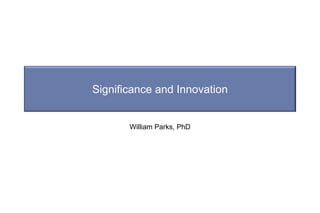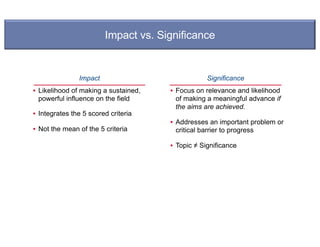How to Craft the "SignificanceŌĆØ & "Innovation" Sections of a Grant Application (2020)
- 1. Significance and Innovation William Parks, PhD
- 2. Scored Review Criteria Investigator Initiated R-series Grants ŌĆó Significance ŌĆó Investigator ŌĆó Approach ŌĆó Innovation ŌĆó Environment Overall Impact Overall Impact or Criterion Strength Score Descriptor High 1 Exceptional 2 Outstanding 3 Excellent Moderate 4 Very Good 5 Good 6 Satisfactory Low 7 Fair 8 Marginal 9 Poor ! ŌĆó Criterion Score ŌĆó Whole numbers: 1-9 ŌĆó 1 (exceptional); 9 (well letŌĆÖs just hope you never get a 9) ŌĆó Given by reviewers but not discussed at study section ŌĆó Provided in Summary Statement of all applications ŌĆó Overall Impact Score ŌĆó Not the mean of the criteria scores ŌĆó Different criteria are weighted by each reviewer ŌĆó Final Impact Score, Percentile ŌĆó Mean of all scores x 10 Ō׿ 10 ŌĆō 90 ŌĆó Percentiled against R01s applications across 3 meetings
- 3. R01 Grant Sections ŌĆó Face Page ŌĆó Table of Contents ŌĆó Performance Site ŌĆó Project Information ŌĆó Project Description: Abstract ŌĆó Project Narrative: 2 sentences ŌĆó Facilities and Other Resources ŌĆó Equipment ŌĆó Key Personnel ŌĆó Biosketches ŌĆó Budget (all years) ŌĆó Budget Justification ŌĆó Cover Page Supplement ŌĆó Introduction (resubmission only) ŌĆó Specific Aims ŌĆó Research Strategy ŌĆó Significance ŌĆó Innovation ŌĆó Approach ŌĆó Preliminary Data ŌĆó Research Plan ŌĆó Protection of Human Subjects ŌĆó Women & Minorities ŌĆó Planned Enrollment Table ŌĆó Children ŌĆó Vertebrate Animals ŌĆó References Cited ŌĆó Multiple PI Plan ŌĆó Letters of Support ŌĆó Resource Sharing ŌĆó Authentication of Key Biological and/or Chemical Resources ŌĆó Checklist
- 4. Innovation
- 5. Innovation ŌĆó Two flavors 1. New concepts or challenges to existing paradigms or dogma 2. New reagents, assays, technologies, etc. ŌĆó However, proposals do not need to be innovative ŌĆó Thus, not a major review criteria ŌĆō but can be a big plus
- 7. Innovation ŌĆó Keep it short ŌĆó 1 paragraph ŌĆó Be realistic
- 8. Significance
- 9. What is Significance and How is it Evaluated? ŌĆó Not related to the disease or cellular process you are studying ŌĆó After all, all diseases are significant ŌĆó Basic science research can have an impact ŌĆó Rather, if the aims are achieved, will scientific knowledge, technical capability, and/or clinical practice be improved? ŌĆó Hence, Research Approach impacts Significance ŌĆó Does the project address an important problem or critical barrier to progress in the field? ŌĆó A wet-lab proposal that is descriptive or derivative or will gather correlative information will not be significant - Epidemiology or clinical studies may seek associative findings ŌĆó Evaluation of and attention to rigor
- 10. Common Misconception ŌĆó Significance only means translational science, clinical importance, and/or disease related ŌĆó Not true: basic research can have a great an impact ŌĆó ŌĆ£NIHŌĆÖs mission is to seek fundamental knowledge about the nature and behavior of living systems and the application of that knowledge to enhance health, lengthen life, and reduce illness and disability.ŌĆØ ŌĆó An application does not need to show the potential for clinical impact
- 11. ŌĆó Describe the strengths and weaknesses/gaps in the rigor of the prior research (published and unpublished) that serves as the key support for the proposed project and plans to address weaknesses/gaps. ŌĆó Rigor: Strict application of the scientific method to ensure robust and unbiased experimental design, methodology, analysis, interpretation, and reporting of results. ŌĆó Variables: sample size, sex, age, weight, health condition, etc. ŌĆó Must address sex (approach) ŌĆó Authentication of key biological and/or chemical resources (1 page) ŌĆó Rigor: must be addressed by reviewers under both Significance (previous) and Approach (planned) ŌĆó https://grants.nih.gov/grants/peer/guidelines_general/Reviewer_Guidance_on_Rigor_and_Transparency.pdf ŌĆó https://grants.nih.gov/grants/guide/notice-files/NOT-OD-18-228.html Significance ŌĆō Rigor of Previous Work, Yours and Others
- 12. WhERE IN THE APPLICATION? RESEARCH STRATEGY 1 The research strategy ŌĆó Describe the strengths and weaknesses in the rigor of . ŌĆó Describe plans to address weaknesses in the rigor of the prior research. are factored into research designs and analyses. Introduction to Applications Research Strategy Vertebrate Progress Report Publication List REVIEW GUIDELINES 3 also be asked to (see Update 2)! ŌĆó Is the prior research rigorous? address weaknesses in the rigor of prior strategies to ensure a robust and unbiased approach relevant biological variables, such as sex, ATTACHMENT FOR AUTHENTICATION OF KEY BIOLOGICAL AND/OR CHEMICAL RESOURCES 2 resources used in the proposed studies. CELL LINES SPECIALTY CHEMICALS ANTIBODIES OTHER BIOLOGICS Standard laboratory reagents that are not expected to vary do not need to be included in the plan. Examples are buffers and other common biologicals or chemicals. DO NOT put experimental methods or preliminary data in this section DO focus on authentication and validation of key resources What are the four elements of rigor? RIGOR OF THE PRIOR RESEARCH 2 RIGOR OF THE PROPOSED RESEARCH 3 BIOLOGICAL VARIABLES 4 AUTHENTICATION what you need to know Send inquiries to reproducibility@nih.gov See also NIH Notice NOT-OD-18-228 NIH ENHANCING REPRODUCIBILITY GUIDELINES
- 13. Significance (Background) ŌĆó 1-1.5 pages ŌĆó Critically review the literature and provide a clear premise ŌĆó No limit on number of citations ŌĆó Original, timely papers over reviews ŌĆó Rigor: Point out gaps and flaws; strengths, too ŌĆó Do not be afraid to say you disagree with something (but explain why and how you will correct this travesty) ŌĆó Be diplomatic ŌĆó Limit discussion to things (pathways, diseases, molecules, etc.) you will study ŌĆó Show (tempered) enthusiasm ŌĆó Know your audience ŌĆó Get the reviewers interested Pet Peeves ŌĆó Needlessly long ŌĆó Not focused ŌĆó Not timely nor scholarly ŌĆó Reliance on reviews ŌĆó Uses the word ŌĆ£excitingŌĆØ more than once ŌĆó Poorly developed premise ŌĆó Does not address rigor
- 14. Impact vs. Significance Impact ŌĆó Likelihood of making a sustained, powerful influence on the field ŌĆó Integrates the 5 scored criteria ŌĆó Not the mean of the 5 criteria Significance ŌĆó Focus on relevance and likelihood of making a meaningful advance if the aims are achieved. ŌĆó Addresses an important problem or critical barrier to progress ŌĆó Topic ŌēĀ Significance














